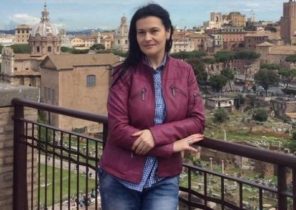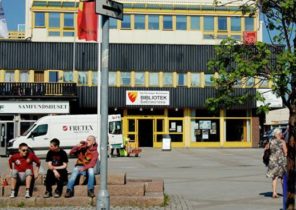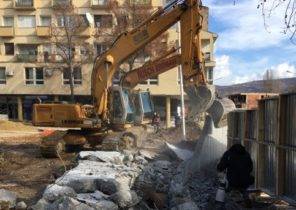
From Khabarovsk to Tokyo and Seoul closer, than to Moscow, and from China in General he is just 30 kilometers away. This city, located in the Russian far East, Siberia, has so little of the East, it seems that he refers to the European part of Russia.
No direct flights are available from Moscow bole lasts seven hours. In the vast spaces of Russia are not so much in more remote places and cities of Vladivostok, Petropavlovsk-Kamchatsky, Sakhalin.
I will fly from Moscow at sunset, but since our way lies to the East, the darkness comes. It’s a very strange feeling to fly so many hours across the country, and the night never comes, infinitely long is the dawn.
The far East is a vast area to the East of Siberia, which reaches the Pacific ocean. I always thought that it is a utopia, but, nevertheless, our plane almost flew over the Arctic circle and is approaching the destination.
The far East, whose area is six times more Patagonian, was the last place of development of new lands by Russia. Russian began to settle there in the mid XIX century.
And until that time there were only indigenous people, and the border is constantly re-shaping the Chinese, confident in the fact that the harsh climate and cold are unlikely to draw on these lands to new settlers.
The Russian also had doubts about the feasibility of the development of these lands, was eight thousand kilometers from Moscow. Therefore, recommendations for the development of these lands to the Russian Tsar Explorer and traveler by Iron habarovym approximately 1650, began to be implemented only in 200 years.
Even before reaching the Pacific coast, Khabarov fully appreciated the economic attractiveness of these territories and appealed to the Russian Tsar Alexey Mikhailovich with the request to raise the Russian flag here. The flag was eventually raised and glorified Explorer, naming the city in his honor.
Tropical heat
I arrived in Khabarovsk in the summer afternoon, and the first surprise that was waiting for me, was exhausting heat. With average temperature of 0º it is hard to imagine the tropical heat in this city in July-August. Especially because I already knew that —30º in the winter are not unusual, and violent Amur river (the border with China for the past 2 thousand 500 kilometers) is covered with more than meter thick ice.
No matter how incredible it may seem, within a few weeks of the year in Khabarovsk are unbearable heat and humidity at any time can go short and heavy rain. With the onset of tropical heat, all in change. Skates, boots and hats with earflaps hide away, and people go to enjoy the warmth and sun.
Cupid furrowed by boats, couples strolling along the seafront, in the parks that sell ice cream. Right on the shore of the beach, and people sunbathing on the sand, splashing in the water.
Khabarovsk lies along the Amur river for 45 miles. In summer boats go before sunset. Some passengers get to their cottages, while others just do the river walk. And although Cupid is in itself sufficiently attractive to travel by boat, another motive for making the river walk is the huge railway bridge over the river, depicted on the 5-thousand dollar bill.
The construction of the bridge was a real engineering feat and labour. The metal structure was made in Poland and from there delivered to Khabarovsk by sea and overland transport on a long route through Europe, the Suez canal, Indian and Pacific oceans.
When almost 100 years ago, “the Amur miracle” was built, it was the longest bridge in Eurasia. Although now it’s not the sites with farms, his image continues to be a hallmark of the city.
In the second half of the day the water in the river, in which many islets, becomes dark blue shade, on the banks of the South-West are visible small hills.
The shiny domes of the Orthodox Cathedral highlights white building and majestic monument to the Governor-General of Eastern Siberia Muravyov-Amursky, seen through the green trees on the river Bank, like a silent water that guards the border with China.
The ship makes a u-turn and shows the city first from the left, then to starboard. Particularly attracted the attention of the parks, almost continuously spreading its greenery along the shore. To the East of tower cranes, there is erected a residential area, rather similar to the whole city. Port cranes are waiting for the arrival of containers with goods from China.
Despite the fact that the eighth hour of the evening, still hot, and the sun is high. The audio guide on the boat tells the story of the city, but this Saturday night, passengers talking animatedly among themselves, not paying attention to the story. Some drink beer, some eat ice cream, and at the next table two couples of pensioners ate fruit from their dacha plots. It’s a little apples and plums. What can be grown during the short summer in the Russian far East.
As soon as the sun sets, the water in the Amur acquires a delightful silver hue, and the cool of evening brings to the ship the smell of pine logs stacked in piles on barges. From the boat can see the Islands that became the subject of an armed dispute between the USSR and China in 60 years. Only a motor boat with a muscular guy, running here and there, breaks the serene silence of the night.
The walk lasts an hour and a half. Returning to the city’s waterfront, we are seeing a lot of activity. The music has many taverns, people happily strolling, someone roller-skates, some on bikes. Children play various games.
Eternal memory about the war
Literally a kilometer away you will find totally different atmosphere. Where the square ends of the Orthodox Church, already on the shore, rises the monument to the fallen in the great Patriotic war, impressive for its size and austerity of lines.
About twenty-five-meter slabs of black marble towering semi-circle around the eternal flame. The simplicity of the monument more eloquent than any words. On the plates in strict alphabetical order are inscribed in gold the names of 40 thousand people, men and women in the Far East who gave their lives to stop the advance of Nazi troops into Russia.
Such monuments are a distinctive feature of Russian cities, solemnly Recalling 26 million citizens who died in the Great Patriotic war. At their base there are always fresh flowers that convey warmth to the cold marble.
Metropolitan Argentine
The square of Fame, next to the Cathedral, is another white building with a green roof and Golden domes. The Khabarovsk theological Seminary. In her library there are some books printed in the middle ages, and the monastic chapel is shocking in its beauty.
It is covered with paintings from floor to ceiling, fabulous gold shimmers in the rays of daylight. Images of saints, churches with onion-domed cupolas and priests in black Calotte are an integral part of the impeccable drawings, dominated by bright colors. Russian Orthodox cross with a slanting lower cross bar and the Greek square cross coexist in the same Church space, and a blue shawl, exquisitely embroidered with pearls hanging beneath the icon of the virgin and child.
The priest tells me that the Metropolitan Ignatius, the former head of the Priamursky Metropolitanate, recently went to Buenos Aires as the Manager of the Argentine and South American diocese of the Moscow Patriarchate. It so surprised me that I even thought it was wrong what then realized. Because Argentina is so far away from Khabarovsk, I find that hard to believe. But it was true. And because of this, the two cities separated by such great distance, found a spiritual connection. My surprise increased when I found out that the only Catholic Church located in the suburbs of Khabarovsk, serves as the Argentine priest.
The right wheel
Khabarovsk, the last major city where a stop for the famous TRANS-Siberian Express before you finish your journey in Vladivostok, located 800 kilometers to the South-East. Despite the fact that Khabarovsk is geographically located in Asia and so close to China, Korea and Japan, it is so Russian town that he was able to separate from Moscow, 200 kilometers, rather than 8.400. In addition, according to associate Professor of Transport University Tatiana Tagirova, “this is the only part of the world where the Chinese had to assimilate, without making changes in the environment”.
Indeed, although Khabarovsk is in Asia, in this city it is difficult to find Chinese or Oriental influence. All buildings built either before the revolution or during the Soviet era or post-Soviet, there is no signage in Chinese or Korean. Only in supermarkets felt some Oriental taste for food, not peculiar to Russian culture.
The bulk of the Eastern component is concentrated in the summer school at the Transport University in which every year come dozens of Chinese boys and girls to learn the language and then study a couple of years in the framework of exchange programmes between universities of both countries.
The rest are tourists from neighboring countries who come to Khabarovsk to get in touch with a part of Europe, the Europe that brought the settlers together with their culture, art and architecture, when the city was founded in 1858, and in forty years has paved TRANS-Siberian railway.
The Japanese spirit is felt only in cars, not only in Khabarovsk, but the whole Russian far East. But this is due to purely economic factors.
Japanese cars are right — hand drive- solid, reliable and at a reasonable price — took a strong position on the market of the country with left-hand traffic. The presence of vehicles with right-hand and left-hand drive in the far East has become a kind of characteristic feature of this part of Russia and a major headache on the road, because the overtaking driver sitting on the right side and not seeing what is happening on the road, can be considered a real feat.
In addition to this feature, Khabarovsk fairly quiet town a few times headed the list of Russian cities with the best quality of life, which is determined by the programs of housing construction, development of urban infrastructure, clear work of utility services during the winter, and transport security. To this list should be added the number of Sunny days in a year (more than in Moscow) and a low level of environmental pollution.
In fact, the city is welcoming the silence, there are a lot of birds, mostly small ones. I wonder where they fly every winter, when the temperature inevitably drops to 20º below zero.
Evening in the country and in the bath
April cottages seizure activity begins, and soon on private land the flowers bloom and there is greenery. Gardeners are proud of their homes and land, diligently treating them, as if to make up for the harsh winter.
Put the tomatoes, cucumbers, potatoes, greens, Apple trees, garden flowers. The garden work begins, as soon as the temperature rises above 0º. But sometimes early April destroyed the works of the late frosts and morning fogs.
Invitation to the country — a veritable feast. Hope and Marat not only their country, the depth of the lot they put the bath in the winter and in the summer bathing on Saturdays with his friends, accompanying all this abundant food.
Bath is not only the oldest method of detoxification of the body in a humid atmosphere at high temperature. It is also an occasion to get together, relax together, to communicate. They have their own rules and regulations. The temperature is adjusted to 70º or more, how to survive guests, brewed with boiling water birch brooms that fills the room with wonderful aroma. Then go to the steam room and they are saturated with cold water that stimulates blood circulation. Sometimes instead of cold water thrown in the snow, if it already covered the entire garden plot. The main thing in the bath is that the taps in the steam room are interspersed with long breaks during which they drink tea from the samovar and talking. And ends all the abundant dinner. In this case, the table gave the fish, which the owner of the house was caught in Cupid and he made.
Cottage Marina is located in another part of town. The plot clearly painted seedlings of all vegetables and flowers, and everywhere hanging in the greenhouse tomatoes and cucumbers. There are also climbing plants, cabbage. At one end of the plot the house stands, and the other is a pond supplying water to the entire area.
Marina is also associate Professor of French. She invites us to the table Laden with a variety of dishes. Everywhere there is dill, his smell is felt even in the air. He clearly went beyond condiments to salads. The hostess serves wine, fish, cooked on the coals. Specifically for his Argentine guest she bought pears, made his way to 20 thousand kilometers of Patagonia.
Then comes the turn of the dessert on the table there is a stunning tart with some berries that grow in these places. We had a long and deep conversation at the table after a meal. But it’s time to say goodbye. After any visit to the country will certainly give you any fruit grown in the area. Gave me a few jars of jam, a bag of tomato and dill, which I enjoy in the last days of his stay in the far East of Russia.







